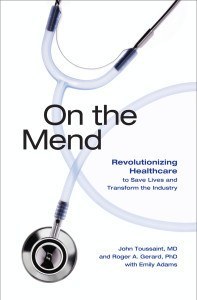ThedaCare, the health system in Wisconsin, often gets a lot of attention for the Lean improvements in their four hospitals, but they are also doing some excellent work in redesigning primary and specialty care, as well (as highlighted in this article: “ThedaCare Encircle Health focus on lean practices“).
John Toussaint, CEO Emeritus, recently blogged about the Director of AHRQ, Dr. Carolyn Clancy and her visit to ThedaCare and their Kimberly Clinic (see video there, too).
From the article:
Dr. Fred Panzer, president of Radiology Associates of Appleton, one of 17 medical tenants at Encircle Health, said from an operations standpoint, the facility is running fine.
“There may be a few kinks here and there, but that's what continuous improvement is all about,” said Panzer, who also is a board member of Encircle Health.
Panzer is referring to ThedaCare's lean journey, which began about seven years ago. The health care system incorporated some efficiency production methods developed by Japanese vehicle maker Toyota to take out waste in its care system.
As Steven J. Spear writes in Chasing the Rabbit / The High-Velocity Edge, nobody designs a perfect system. It's a “Lean Thinking” principle that we aim for perfection as a goal, even if we're likely to have a few kinks in the short term. We keep striving for better, instead of settling for good enough. Instead of being satisfied in our standing amongst benchmarking of peer organizations, we focus on being as good as we can be as a driving force.
The article spells out a Lean process and design for outpatient care, including:
- Standardized exam rooms to eliminate wasted time spent looking for stuff
- A central nurses' station with visibility to exam rooms and visual controls
- A centralized registration area, avoiding duplication of effort amongst different clinics on the site
- On site lab testing to give results of blood work DURING the visit, eliminating the need for the patient to come back to get test results.
You can read more detail in the article.
Of that last bullet point, a primary care doc says:
“Now this is all done in the same visit,” Anderla said. “The patients no longer are waiting for results and we can go the results with them and determine any care action that may be necessary.”
That illustrates perfectly that Lean isn't about cost-cutting. It's about reducing timelines and improving quality – faster diagnoses lead to better care.
In another example of reducing time and improving care:
Having a variety of services under one roof improves patient care.
Dr. Mark Chelsky, with Valley Urologic Associates, recently saw an elderly patient, but before he could determine a course of treatment, he needed the patient to get a CAT scan of an area around a kidney. Because the service was on site, he was able to schedule the appointment the same day.
“She lived in Waupaca and didn't have to come back to have the CAT scan,” he said.
Simple cost-cutting can't bring the types of true effectiveness that you get with Lean thinking and Lean methods. ThedaCare continues to prove that and I'm glad they continue to share their stories.
 Read more about ThedaCare in the new book from LEI, launching today called On the Mend: Revolutionizing Healthcare to Save Lives and Transform the Industry:
Read more about ThedaCare in the new book from LEI, launching today called On the Mend: Revolutionizing Healthcare to Save Lives and Transform the Industry:
Twitter: www.twitter.com/onthemendbook
Facebook: www.facebook.com/onthemendbook
We're launching the book in conjunction with Day 1 of our first Lean Healthcare Transformation Summit, starting today in Orlando. Stay tuned about that or follow @markgraban, @LEIevents, or @LEIhealthcare for more over the next two days.
What do you think? Please scroll down (or click) to post a comment. Or please share the post with your thoughts on LinkedIn – and follow me or connect with me there.
Did you like this post? Make sure you don't miss a post or podcast — Subscribe to get notified about posts via email daily or weekly.
Check out my latest book, The Mistakes That Make Us: Cultivating a Culture of Learning and Innovation:










[…] ThedaCare, Lean, and Primary Care in the News by Mark Graban – “Lean isn’t about cost-cutting. It’s about reducing timelines and improving quality – faster diagnoses lead to better care.” […]